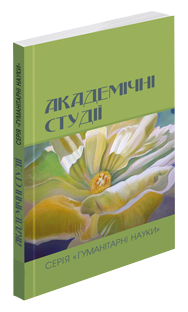Abstract
The article is devoted to the study of slang vocabulary and its role in the process of stylistic design of the text of the novel “Zagrava” by Viktor Veretennikov. It was found that it performs several key functions, in particular sociotypological, expressive and characterological. Such vocabulary not only gives the characters’ speech emotional inspiration and individuality, but also serves as a means of authentically reproducing the social, cultural and psychological context of the depicted era. In the course of studying slang vocabulary as a linguistic means of expressing emotional and social color in the novel “Zagrava” by Viktor Veretennikov, it was found that the use of non-literary vocabulary, in particular socially marked slang, is not only a stylistic device, but also an important component of the author’s individual speech, aimed at forming an authentic communicative atmosphere. The involvement of various layers of slang vocabulary in a literary text – youth, military, prison, professional – is not an accidental or decorative element, but a systematic linguistic and stylistic strategy of the author. It was found that slang in the work performs a number of functions: characterological (individualizes the speech of the characters, reflecting their age, social status, mentality, life experience), expressiveemotional (gives the text energy, tension, helps to convey anger, fear, contempt, sarcasm), identification (determines the character’s belonging to a certain social or subcultural environment), stylization (creates the effect of authenticity, naturalness of artistic speech) and aesthetic-semantic (deepens the content of conflicts, interpersonal relationships, worldview oppositions in the novel). Slang vocabulary in modern Ukrainian prose, in particular in Viktor Veretennikov’s novel “Zagrava”, is not a peripheral phenomenon, but an organic element of the stylistic, communicative and ideological structure of the text. Its systemic and functionally determined use requires further interdisciplinary understanding – at the intersection of linguistics, cultural studies, social psychology and literary studies.
References
Бондаренко К. Л. Лінгвокультурні особливості українського та англійського сленгу : автореф. дис. ... канд. філол. наук : 10.02.17. Донецьк, 2007. 17 с.
Веретенников В. О. Заграва : роман. Київ : ВЦ Академія, 2009. 304 с.
Грабовий П. М. Когнітивні параметри українського молодіжного сленгу : автореф. дис. … канд. філол. наук: 10.02.01. Київ, 2010. 18 с.
Жадан С. Ворошиловград. Харків : Фоліо, 2012. 442 с.
Загнітко А. Словник сучасної лінгвістики : поняття і терміни. Донецьк : ДонНУ, 2012. Т. 2. 350 c.
Карпа І. Dобло і зло. Харків, 2008. 320 с.
Колоїз Ж. В. Українська неологія : здобутки та перспективи. Наукові праці Чорноморського державного університету імені Петра Могили. Сер.: Філологія. Мовознавство. 2009. Т. 105. Вип. 92. С. 57–62.
Корнєлаєва Є. Сленг як об’єкт лінгвістичного дослідження. Науковий вісник Херсонського державного університету. Серія: «Лінгвістика». 2019. Вип. 35. С. 80−84.
Кондратюк О. Молодіжний сленг як мовне явище. URL: http://www.ji.lviv.ua/n38texts/38-zmist.htm
Метаморфози. 10 українських поетів останніх 10 років : збірка / уклад. С. Жадан; післям. В. Неборака. Харків, 2011. 272 с.
Назаревич Л., Гавдида Н. Професійний та молодіжний жаргони: особливості вживання у студентському середовищі. Одеський лінгвістичний вісник. Одеса, 2015. № 5. С 99–103.
Селіванова О. О. Основи теорії мовної комунікації. Черкаси : Видавництво Чабаненко Ю. А, 2011. 350 с.
Словник українського сленгу. URL: http://slovopedia.org.ua/57/53392-0.html
Словник сучасного українського сленгу / уклад. Т. М. Кондратюк. Харків : Філіо, 2006. 350 с.
Ставицька Л. Арго, жаргон, сленг. Соціальна диференціація української мови. Київ : Критика, 2005. 464 с.
Стадній А. С. Нові оцінно-конотативні значення дієслів у суч. укр. літ. мові (на матеріалі ЗМІ) : автореф. дис. … канд. філол. наук : 10.02.01. / Нац. пед. ун-т ім. М. П. Драгоманова, Київ. 2011. 19 с.
Столяр М. URL: https://shron1.chtyvo.org.ua/Stoliar_Mariia/Molodizhnyi_slenh_u_postmodernii_ukrainskii_prozi_prahmalinhvistychnyi_aspekt.pdf?
Сюта Г. Мова художньої літератури і літературна мова. Культура слова. Київ : Вид. дім Дмитра Бураго. 2012. Вип. 77. С. 120–127.
Чорнобай В. Г. Сленг : історія виникнення, визначення поняття. Науковий вісник Національного університету біоресурсів і природокористування України. Серія: Філологічні науки. 2014. Вип. 206. С. 76–81.
Batsevych, F. (2004). Osnovy komunikatyvnoi linhvistyky [Basics of communicative linguistics]. Kyiv: Akademiia. 344 p.
Selivanova, O. (2011). Osnovy` teoriyi movnoyi komunikaciyi [Basics of language Communication Theory]. Cherkasy`: Vy`davny`cztvo Chabanenko Yu. A. 350 р.
Delisle, J. (1981). L’Enseignement de l’interprétation et de la traduction. Ottawa : Editions de l’Université d’Ottawa. 321 p.
Newmark, P. (1995). Textbook of Translation. C. : Library of Congress Cataloging-in-Publication Data. 457 p.
Nida, E. (1974). The Theory and Practice of Translating. C. Taber. N. Y. : Brill, Leiden. 195 p.

This work is licensed under a Creative Commons Attribution 4.0 International License.

